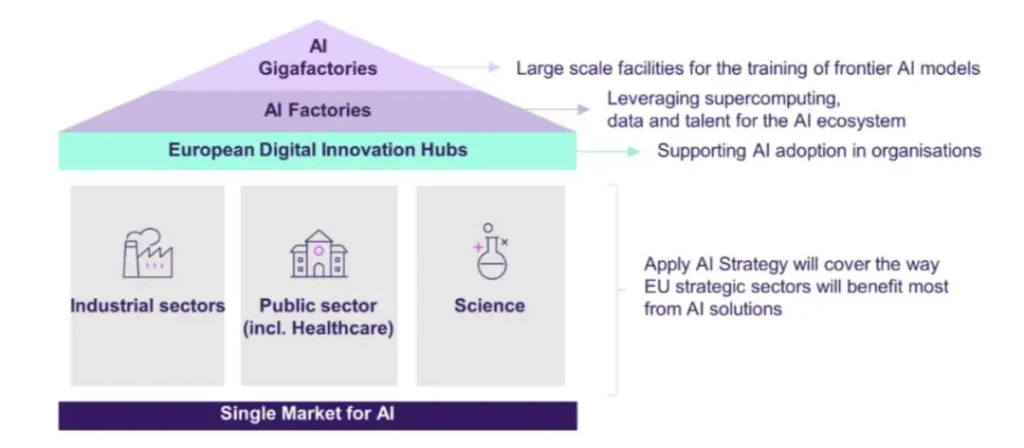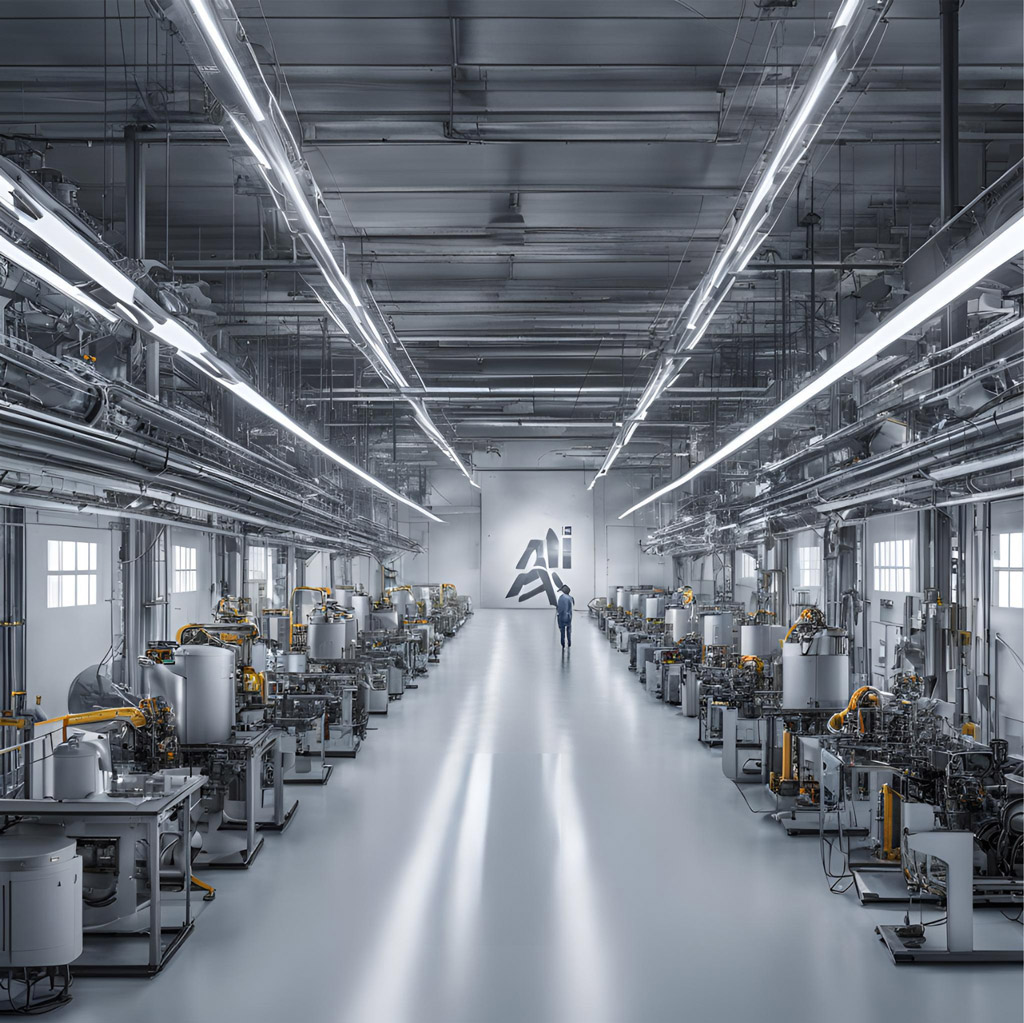EU AI Continent Action Plan: Building Europe’s AI Leadership Through Strategic Infrastructure
The European Union has unveiled an ambitious initiative to position itself as a global leader in artificial intelligence. The “AI Continent Action Plan” represents a comprehensive strategy to boost AI development across Europe while enhancing the bloc’s strategic autonomy in this critical technology sector. With growing competition from the United States and China, the EU is taking decisive steps to establish itself as a serious contender in the global AI race.
The Strategic Vision Behind the EU AI Continent Action Plan
European Commission President Ursula von der Leyen has made it clear that world AI leadership is “up for grabs,” and the Commission is determined to make Europe a major player. At the Paris AI Action Summit in February, von der Leyen announced the InvestAI facility, designed to mobilize up to €200 billion for AI investments across the continent.
The AI Continent Action Plan is structured around five key pillars:
- Computing infrastructure
- Data ecosystems
- Skills development
- Regulatory simplification
- Adoption in strategic sectors
This strategy represents a significant evolution of previous EU initiatives on AI, building upon the foundation established by the 2018 AI strategy, the 2021 Coordinated Plan on AI, and the AI Innovation Package launched in January 2024.
The Tiered Infrastructure: AI Factories and Gigafactories

AI Factories: The Building Blocks of Europe’s AI Network
At the heart of the EU’s AI infrastructure are the AI Factories—open AI ecosystems providing access to computing power, data, and talent. The first 13 AI factories have been strategically placed across 17 member states and two participating countries, covering ten strategic sectors including healthcare, manufacturing, energy, and agriculture.
Notable examples include:
- Finland’s LUMI AI Factory (LAIF): Built around the world’s 8th-ranked LUMI supercomputer, it features next-generation GPU and CPU acceleration nodes supporting the entire AI workflow from training to real-time inference. It has shown particular strength in automated modeling for manufacturing and medical image analysis.
- Germany’s HammerHAI Factory: Specifically designed for engineering and manufacturing needs, it employs a hybrid “cloud-native + supercomputing” architecture to lower barriers to AI computing access for SMEs, enabling AI-driven product design and production optimization.
- Spain’s BSC AI Factory: Features the upgraded MareNostrum 5 supercomputer with specialized AI computing modules capable of training trillion-parameter models, offering three times the computing power of its predecessor.
By the end of 2025, the AI factory network will be fully operational, with an additional nine AI-enabled supercomputers bringing a 300% increase in overall computing capacity compared to 2024 levels. This will create an innovation hub combining supercomputing, data, and talent across Europe.
Gigafactories: Powering Frontier AI Development
Recognizing that distributed AI factories alone cannot meet the demands of frontier AI models (including development toward artificial general intelligence), the EU has launched the Gigafactories initiative. This ambitious plan aims to build five facilities with massive computing power, each equipped with over 100,000 advanced AI processors.
The JUPITER supercomputer exemplifies this approach, with 1.5 ExaFLOPS of computing power and AI modules using neuromorphic chips for sparse computing, achieving 20 times the training efficiency of traditional GPUs for billion-parameter models.
Beyond raw computing power, the Gigafactories initiative promotes supply chain autonomy by accelerating the deployment of European-designed AI chips in line with revisions to the EU Chips Act. For example, France’s Alice Recoque supercomputer is piloting European-designed AI chips to achieve “technological sovereignty” in computing power.
Data Union Strategy: Creating a Robust Data Ecosystem
The EU recognizes that while computing infrastructure forms the “skeleton” of its AI strategy, data ecosystems represent its “flesh and blood.” With only 13.5% of European businesses currently capable of sharing data, the EU has developed the Data Union Strategy to address this limitation through three major initiatives:
1. Data Labs for Deep Integration
Data Labs serve as standard modules within AI factories, responsible for data cleaning, synthesis, and cross-domain federated learning. Greece’s Pharos factory language data lab integrates linguistic resources from 17 countries to build a multilingual corpus covering 24 EU languages, supporting cross-lingual large language model training and potentially increasing internal trade efficiency by 15%.
2. Interoperable Data Spaces
Through the Simpl sharing software framework, the EU is connecting nine major European data spaces across sectors like healthcare, energy, and agriculture. After the Dutch healthcare data space was integrated with the LUMI factory, AI cancer diagnosis models saw a 400% increase in training data and accuracy improvements from 82% to 91%.
3. Compliant Sharing Mechanisms
Based on the Data Governance Act framework for trusted intermediaries, Italy’s IT4LIA factory has developed “data sandbox” tools allowing SMEs to share industrial data after anonymization, meeting GDPR requirements while creating industry-level datasets. For example, a textile defect image library has already collected 5 million samples.
Industry Applications: From Technology to Real-World Impact
The EU’s “Apply AI Strategy” drives technology implementation through a closed-loop application model combining computing power, data, and real-world scenarios:
Manufacturing Applications

- Germany’s HammerHAI factory provides AI-driven predictive maintenance models for automotive parts companies, reducing equipment downtime by 35% through edge computing nodes for real-time production line optimization.
- Poland’s PIAST factory has developed robotic collaboration systems using supercomputer-trained reinforcement learning models, enabling welding robots to adapt to complex curved surfaces with precision increased to 0.1 millimeters.
Healthcare Innovations
- The French AI Factory, in partnership with pharmaceutical companies, uses the JUPITER supercomputer to train protein structure prediction models, reducing drug development cycles from 5 years to 18 months.
- Finland’s LAIF factory has developed a personalized radiotherapy planning system based on patient imaging data and supercomputer simulations, reducing radiotherapy side effects by 25%.
Green Transition Solutions
- Luxembourg’s LuxProvide factory has created an energy AI platform integrating real-time power grid data with climate models, achieving wind and solar power generation prediction errors below 5% and supporting a 20% improvement in grid peak-shaving efficiency.
Regulatory Framework: Balancing Innovation and Governance
The EU AI Act’s risk-based framework provides regulatory certainty for technology deployment:
- For high-risk scenarios (such as recruitment and judicial decisions), explainable AI systems developed by Dutch public sector organizations achieve 100% decision traceability.
- For general AI model regulation, Germany is piloting digital watermarking technology to mark AI-generated text, reducing the risk of misinformation spreading.
- For SMEs, the AI Act help desk provides self-assessment tools that reduce compliance costs by 60% and shorten product market entry cycles by three months.
This balanced approach to regulation and innovation both constrains technology misuse and clears obstacles for industrial applications.
Funding and Investment: The Power Behind the Vision
The EU has significantly increased its investments in AI, with the European Commission historically investing around €1 billion annually to mobilize national and private investments of up to €20 billion per year for the 2020-2030 decade.
The InvestAI facility represents a major shift in scale, with €20 billion specifically dedicated to AI gigafactories. Of the €200 billion total, €150 billion will come from the AI Champions Initiative—a private undertaking by over 60 European companies—supplemented by €50 billion from the Commission.
While the actual new funding may be less than headline figures suggest, with only €7 billion already committed by the Commission and member states that can be redirected to the existing EuroHPC Joint Undertaking, the initiative still represents a substantial investment in Europe’s AI future.
Future Outlook: Europe’s Path to AI Leadership
The EU’s AI Continent strategy demonstrates a unique paradigm of technology and industry integration. Its “pyramid” approach to computing infrastructure meets both broad accessibility needs and frontier technology challenges, while the Data Union Strategy opens channels for compliant data sharing and activates cross-domain data value.
Europe’s advantages lie in its “rule-making power” and “ecosystem integration capability.” The AI Act sets global standards for trustworthy AI, while data spaces and computing networks build cross-sovereign technical cooperation systems.
Over the next five years, the productivity of AI factories, the implementation of the first Gigafactories, and the effectiveness of data alliances will be key indicators of this strategy’s success. By balancing technological sovereignty with open innovation, the EU aims to gain the initiative in global AI competition while establishing a new reference framework for global AI governance.